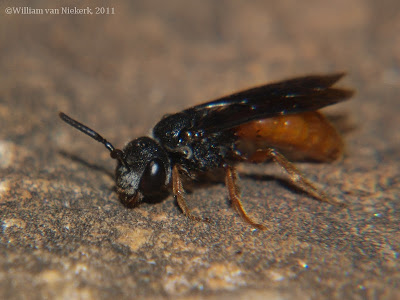.JPG) |
| On Kingley Vale, West Sussex, UK, March 2013. Photographed using the same-old-same-old of Olympus E-420 with Zuiko 40-150mm lens and three KOOD magnifiers. |
Which brings us to our discussion for the day.
The monstrosity which is managed heathland.
Heathland, for those who don't know, is an ecologically interesting slow-transitional phase vegetation assemblage naturally occurring in areas where fire and the resultant changes to the soil have eradicated the dominant assemblage.
Which is to say, it turns up after fire has killed the trees and made the soil uninhabitable to them. It is predominantly composed of the heathers, hence the name 'Heath', and lasts for a couple of hundred years until the soil is de-acidified and more competitive vegetation crowds out the heather.
Because nature abhors a vacuum, there are all sorts of animals and plants that thrive on heathland and - in cases such as this particular spider - in other transient habitats.
This might seem unlikely - evolution doesn't produce novel species overnight, and any specialist is dependant upon the continued existence of a particular niche. If this niche is by its very nature transient, the expectation is that if specialists do have time to develop, they'll be wiped out a couple of centuries down the line.
They're not constantly being wiped out, however, because even England is a fairly big place, and in a big place (formerly) covered in forest, large swathes would burn down frequently enough that the specialists had plenty of time to colonise new tracts before the old habitat was swallowed up by forest again.
This, by the way, is called a dynamic mosaic. Its the nature of, well, nature; over a large enough area, rare events happen frequently enough that, although precisely where it is changes, 'unique' habitats pop up frequently enough to be a constant feature of the landscape.
Britain is not, it is important to note, currently covered in forest.
At this point I would like to be able to console you that the 12% forest cover is averaged over the entirety of the UK, including the far north where many trees haven't yet caught up with the habitat that opened up when the glaciers left.
However, although the Forest commision seems oblivious to the fact that our forests are in a grossly unnatural state, they also give state-based percentages. Scotland, which would naturally host the (almost extinct) Caledonian Forest, has 16% cover; much of which is non-native (and ecologically almost useless) plantation conifer. England and Wales, both of which would, naturally, be almost entirely forested, have only 9% and 12%, respectively.
As a result, our dynamic mosaic is fractured - farmland and sprawl separate what remains of flammable forest and re-growing heathland, and most, if not all, of that forest is being used as a profitable resource, and so natural spread of fires is even more restricted. Taking everything into account, our native forest becomes almost as scarce - perhaps scarcer still - than the formerly rare, transitional environments that make up many of our national parks.
So environmental management has taken the rather controversial step of forcing these dynamic environments to be static. A national park once a heathland must not be allowed to return naturally to forest, but must be maintained as heathland. To preserve the unique habitat and assemblage, among other things.
And how, pray, is much of this maintenance done?
It might seem intuitive; controlled burning.
Spiders - along with insects, lizards, snakes and a surprising number of heath-dependant plants - do not survive fire in any stage of their life-cycle. As much as they may thrive in the area where a fire has formerly altered part of a larger habitat, they can neither escape nor tolerate the flames.
It is worth noting that not all heathland is managed by controlled burning; some is grazed - however, for many profitable grazing birds and mammals, heather is only palatable in young growth, a state which is encouraged by management by... yes, burning.
I'm not going to pretend to have a solution to this problem; I simply wish to make a note of the paradox that environmental management in the UK has become.
And, having done so, on with the taxonomy:
This spider - for a reminder,
is
Alopecosa barbipes
(Sundevall, 1833)
Which is a fox spider. Fox spiders, it's important to note, are a genus (Alopecosa) of wolf spider (Lycosidae).
- Lycosinae
- Lycosidae
- Lycosoidea
- Entelegynae
- Araneoclada
- Neocribellatae
- Araneomorphae
- Opisthothelae
- Araneae
- Megoperculata
- Micrura
- Arachnida
- Chelicerata
- Arthropoda
See also Ligia oceanica, Metisella willemi, Acada biseriata, Anthocharis cardamines, Laelia robusta, Zebronia phenice, Crambus pascuella, Senaspis haemorrhoa, Helophilus pendulus, Episyrphus balteatus, Diasemopsis meigenii, Dolichotachina caudata, Megistocera filipes, Metadon inermis, Panorpa germanica, Melolontha melolontha, Malachius bipustulatus, Demetrias atricapillus, Otiorhynchus atroapterus, Cheilomenes lunata, Anthia fornasiini, Oedemera noobilis, Synagris proserpina, Vespula germanica, Astata tropicalis, Hagenomyia tristis, Andrena nigroaenea, Pephricus, Anoplocnemis curvipes, Ranatra, Grypocoris stysi, Cyathosternum prehensile, Lobosceliana loboscelis, Stictogryllacris punctata, Sibylla, Humbe tenuicornis, Pseudagrion hageni, Enallagma cyathigerum and Rhyothemis semihyalina
- Ecdysozoa
- Protostomia
- Nephrozoa
See also Burhinus vermiculatus, Sterna hirundo, Ardea goliath, Chalcophaps indica, Thelotornis capensis, Trachylepis varia, Lygodactylus capensis, Hipposideros vittatus, Rana temporaria, Chiromantis xerampelina, Synchiropus splendidus and Troglodytes troglodytes
- Bilateralia
- Eumetazoa
- Animalia
- Eukaryota
And that's all, folks!
Many great resources exist for British spiders, but one very handy online tool is the Spider and Harvestman recording scheme. Most species - of spiders, at any rate - have a complete description and at least one photograph; those that don't are typically extremely rare to extinct in the country. It could be more user friendly, but for that there are pages like the Sherwood-centric Eakring Birds and the Leicestershire/Rutland site NatureSpot

.JPG)
.JPG)




.JPG)
.JPG)
.JPG)

